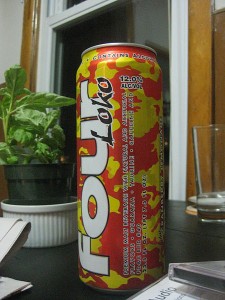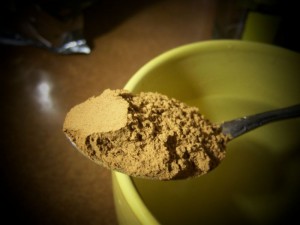Four Loko, the high alcohol high energy drink, has received a lot of attention lately (including from us – see “Alcoholic Energy Drinks More Than Most Can Handle” for more). There has been some new discussion locally as North Carolina contemplates doing what New York state recently did by banning the drink. At the moment Governor Perdue has asked manufacturers to voluntarily stop selling alcoholic energy drinks in the state.
The University of North Carolina Wilmington’s Substance Abuse and Prevention Office notes that most of the kids on campus caught drinking have been drinking Four Loko (WECT 6). The students of the school interviewed for the article made clear that it is potent stuff. It does, after all, have a 12% alcohol content and enough stimulants in it to mask normal feelings of drunkenness. But does that warrant a ban?
Why Ban Four Loko?
There are a few arguments on this. Some have accused Four Loko of intentionally marketing to younger people. The design on the cans is bright and colorful and looks more or less like any other energy drink you would buy. By virtue of this association it seems that kids underestimate the punch that each can packs. Which leads us to the second point – the can is almost 24 ounces, twice as large as a beer. The alcohol content is about three times that of a light beer. Basically, finish one can of Four Loko (which is only a few dollars – the price is one of its selling points) and you’ll have had the equivalent of a six pack, and jitters on top of that. You will most likely be drunk, or very drunk. And not only will you have consumed a six pack, you will also have simultaneously consumed the equivalent of two Red Bulls. Why’s that? Because one 8.3 oz can of Red Bull only has 76 mg of caffeine in it…while Four Loko has 156 mg of caffeine.
Designed For Drinking
That Four Loko is packaged in such a manner is part of the problem. It is not so much the eye-catching design, but the size of the can that presents the issue (in my mind anyway). Once you open the can, you’re going to have to drink it or throw it out – it’s a carbonated beverage and will go flat like a soda does if left to sit. You’re not purchasing a can of the drink to have as an apéritif over a few days. You’re drinking the whole thing once it’s opened, and as pointed out above, that will definitely make you drunk. It’s immoderation by design.
The Stimulants
Then you have the fact that the beverage contains a number of stimulants. Those stimulants are caffeine, taurine, and guarana. When they mix with alcohol (in this drink and in many others, including cocktails) they can have unexpected effects. As our previous blog noted, people drinking an alcoholic energy drink believe their motor coordination is better than those who do not have those ingredients in their drink. If you do not feel as drunk as you are, you may be inclined to continue drinking, and the signals from your body that say you’ve had enough may not be clearly perceived. This is the aspect of alcoholic energy drinks that leads to hospitalization. But there are other negative effects too.
A study at Wake Forest University in 2006 found that those who mix energy drinks with alcohol are more likely to sexually assault or be sexually assaulted, more likely to get in a car with a drunk driver, and more likely to require medical treatment (see the Daily Collegian for more info). In other words it’s much more likely that destructive and risk-taking behaviors will be pursued. Aimee Hourigan of the UNCW Substance Abuse and Prevention Office in an interview with WWAY3 noted that “You’re more likely to get into a fight and have other negative consequences related because your body’s just not equipped to handle that much alcohol and stimulant at the same time.”
An Experiment
The actual effect of drinking a Four Loko was measured recently by a local Raleigh woman. Drinking four ounces every half a hour (a pace probably considered slow by college standards), she measured her blood pressure and pulse through the process. When she started out her blood pressure was 116 over 64; in 4 ounces’ time it went up to 192 over 36 and her heart was racing at 154 beats per minute. The woman, a registered nurse, had her verdict. Feeling sick after 8 ounces, she stopped, and told WALB10 news that “if you’re not careful, you could kill yourself with this.”
A Matter of Taste
Finally, in terms of taste, people will disagree, but it seems clear that the drink wasn’t made for delicate meal pairings. In comes in a number of sugary, fruit like flavors that make it more appealing. All these factors considered, it’s hard to see that it’s anything other than a product made for binge drinking.
A Question of Law
Does this mean that a ban is required? It remains to be seen if this is so. The makers of Four Loko, Phusion Projects, recently published an open letter addressing federal and state inquiry into their beverage. They do sell a version of the drink that contains less alcohol; it’s foreseeable that they may soon only be allowed to sell that version. The popularity of the drink on college campuses is a problem somewhat larger than themselves – college binge drinking is always a problem, especially as it often occurs in crowded situations with many inexperienced if not underage drinkers. Four Loko may be a little too potent for that setting, but that doesn’t mean it couldn’t potentially be enjoyed elsewhere.
As Wilmington and North Carolina in general examine this issue, let us know what you think by leaving comments or sending us an email at cs at homehealthtesting.com. We’d love to hear from you (and remember, it’s easy to keep tabs on your BAC with a disposable and portable alcohol test kit).
For more info, including info on the FDA’s inquiry into alcoholic energy drinks, check out Time’s Healthland.
Headline picture by Taggart, originally for the New York Daily News.





